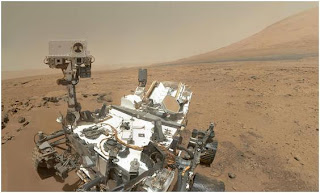 |
| mars-jpl-nasa-gov.jpg |
I’ve been following NASA’s Mars Curiosity Rover @MarsCuriosity on Twitter for several months—along with over 1.2 million others. That’s a hefty following, whether for a government agency or for a robot millions of miles away!
It’s fascinating on several dimensions. What Curiosity is doing is interesting, even to the non-scientist. As a marketer I’m intrigued by the way in which the NASA communications people have established and consistently executed a delightful brand personality. A little digging shows it to be no accident.
The social media team is led by Veronica McGregor who has been Tweeting for NASA since the Mars Phoenix in 2008. Most NASA missions have a Twitter feed, so there is considerable institutional knowledge. One thing the rover teams learned early on was that first person was more engaging than third. It’s also easier to humanize the vehicle and give it a personality. The Mars has frequently been described as “sassy.” McGregor told Forbes:
“Back when Twitter was new, we tried tweeting both ways – in the first and third person. We always got more feedback when we were in first person. It’s also an advantage given the 140 character limit – ‘I am’ is a lot shorter than ‘The spacecraft is.’”
“It’s easier to anthropomorphize rovers,” added Smith. “The cameras make it look like she has eyes. So it’s tempting to think of the rover as a bodacious chick on the surface of another planet with a rock vaporizing laser on her head.
The rover started Tweeting on November 19, 2008 with a naming contest announced by Pixar robot WALL-E. Curiosity was suggested by a Kansas 6th grader, won the online voting, and was announced by NASA in March 2009. All pretty standard stuff–effective in generating awareness of the mission but time consuming. Curiosity’s Facebook page was started in mid-2010; the actual Mars landing was August 2011. So, as usual, this is no social media fluke. It took time, lots of effort, and a real understanding of social media and the various target audiences who might be interested.
How do the three women on the team do it? Have they made any mistakes in execution? This Bloomberg video is less than 3 minutes and gives a lot of insight into those questions.
What constitutes a good brand personality? Brand consultancy Amicus identifies key dimensions:
1. Demonstrates a Brand’s Passion and Expertise … Defining the Brand’s Ultimate Purpose and Differentiating It from the Competitive Set.
2. Creates an Affinity with Targeted Customer Segments … Touching and Energizing their Motivations.
3. Projects the Brand’s Core Values and Beliefs … Describing How Customer’s can Expect to be Treated.
4. Communicates an Over-Arching Tone, Style, and Attitude about the Brand’s Experience and Customer Interactions.
They go on to say, “Personality gives a brand dimension and depth. It can breathe life into inanimate images. It can be the cornerstone for service delivery … and connecting emotionally with customers.” The personality must carry through at all touchpoints to be effective.
The @MarsCuriosity team makes it look easy—which of course it is not. We can all learn a lot from them!
"What Curiosity is doing is interesting, even to the non-scientist." Yes, exactly! I'm definitely one of those non-scientist types and yet news about the Curiosity rover is very exciting to me. Whatever the NASA social media team is doing, the Phoenix social media here should definitely emulate.
ReplyDeleteI'd suggest that it's less emulation and more being inspired to develop a sound strategy with creative execution.
Delete